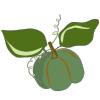Winter Squash are varieties of gourd, pumpkin or marrow that are generally harvested once the fruit have fully matured and developed a hard outer shell. Winter Squashes are great for long term storage as the hard outer shell protects them for months.
How To Grow
Seeds can be sown 1-2 cm deep indoors or outside but need a temperature above 20 Celsius (68 Fahrenheit) to germinate (some will germinate at lower temperatures but your chances are much higher above that). Some find sowing the seed on their side helps prevent rot but test have shown this unlikely to have a big impact on germination rates. When sowing, sow in damp soil / compost and allow to dry out until the seedlings have broken through to the light (then start watering again). When planting outside be careful to protect the seedlings against slugs / snails / and some birds as they will quickly find and destroy them whilst plants are small. Once they have developed a few leaves the size of your hand or bigger they should be able to fend for themselves. There are two types of winter squash plants (bush and trailing varieties). Bush varieties are good when you want the plant to stay in one spot. Trailing varieties will spread out in any direction they choose and may need “trailing” to make sure they grow in the direction you want choose. Trailing varieties can be handy in that you can plant them on the edge or corner of a bed and trail them along a path. This minimises the bed space that they take up. Each squash plant will attempt to produce 3-6 (or more) fruit if you let it, but these are likely to be smaller. For fewer larger fruits remove the extra fruits as they form. This allows the plant to focus its energy on 1-2 larger fruits. Winter Squash are very hungry plants and require lots of nutrients to develop. Make sure you prepare beds with plenty of compost or well-rotted manure (you can’t give the soil too much when it comes to squashes). Once the plants have started flowering, regular (twice weekly) watering with a liquid fertiliser will maximise your harvests. Once fruits start to develop raise them off the ground to prevent rotting. Use whatever you have around (straw is not suggested as it will start harbour rot if the soil stays wet for a prolonged period).
How/When To Harvesting
Cut the stalk of the fruit you want to harvest once the fruit has matured. This is usually when the skin feels hard and there is a change in sound once fruit is tapped (sounds hollow).


